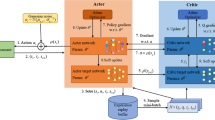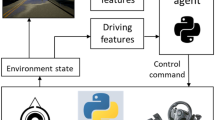Abstract
Autonomous and safe navigation in complex environments without collisions is particularly important for mobile robots. In this paper, we propose an end-to-end deep reinforcement learning method for mobile robot navigation with map-based obstacle avoidance. Using the experience collected in the simulation environment, a convolutional neural network is trained to predict the proper steering operation of the robot based on its egocentric local grid maps, which can accommodate various sensors and fusion algorithms. We use dueling double DQN with prioritized experienced replay technology to update parameters of the network and integrate curriculum learning techniques to enhance its performance. The trained deep neural network is then transferred and executed on a real-world mobile robot to guide it to avoid local obstacles for long-range navigation. The qualitative and quantitative evaluations of the new approach were performed in simulations and real robot experiments. The results show that the end-to-end map-based obstacle avoidance model is easy to deploy, without any fine-tuning, robust to sensor noise, compatible with different sensors, and better than other related DRL-based models in many evaluation indicators.













Similar content being viewed by others
References
Ingrand F, Ghallab M. Deliberation for autonomous robots: a survey. Artif Intell. 2017;247:10–44.
Minguez J, Lamiraux F, Laumond J-P. Motion planning and obstacle avoidance. In: Springer handbook of robotics. Springer, 2016;1177–202.
Mohanan M, Salgoankar A. A survey of robotic motion planning in dynamic environments. Robot Auton Syst. 2018;100:171–85.
Zhang W, Wei S, Teng Y, Zhang J, Wang X, Yan Z. Dynamic obstacle avoidance for unmanned underwater vehicles based on an improved velocity obstacle method. Sensors. 2017;17(12):2742.
Zhou D, Wang Z, Bandyopadhyay S, Schwager M. Fast, on-line collision avoidance for dynamic vehicles using buffered Voronoi cells. IEEE Robot Autom Lett. 2017;2(2):1047–54.
Rösmann C, Hoffmann F, Bertram T. Integrated online trajectory planning and optimization in distinctive topologies. Robot Auton Syst. 2017;88:142–53.
Kahn G, Villaflor A, Ding B, Abbeel P, Levine S. Self-supervised deep reinforcement learning with generalized computation graphs for robot navigation. In: Proceedings of the IEEE international conference on robotics and automation (ICRA), 2018;1–8.
Silver D, Schrittwieser J, Simonyan K, Antonoglou I, Huang A, Guez A, Hubert T, Baker L, Lai M, Bolton A, et al. Mastering the game of go without human knowledge. Nature. 2017;550(7676):354–9.
Vinyals O, Babuschkin I, Czarnecki WM, Mathieu M, Dudzik A, Chung J, Choi DH, Powell R, Ewalds T, Georgiev P, et al. Grandmaster level in starcraft II using multi-agent reinforcement learning. Nature. 2019;575(7782):350–4.
Levine S, Pastor P, Krizhevsky A, Ibarz J, Quillen D. Learning hand-eye coordination for robotic grasping with deep learning and large-scale data collection. Int J Robot Res. 2018;37(4–5):421–36.
Xie L, Wang S, Rosa S, Markham A, Trigoni N. Learning with training wheels: speeding up training with a simple controller for deep reinforcement learning. In: Proceedings of the IEEE international conference on robotics and automation (ICRA), 2018;6276–83.
Chen G, Cui G, Jin Z, Wu F, Chen X. Accurate intrinsic and extrinsic calibration of RGB-D cameras with GP-based depth correction. IEEE Sens J. 2018;19(7):2685–94.
Chen G, Pan L, Chen Y, Xu P, Wang Z, Wu P, Ji J, Chen X. Robot navigation with map-based deep reinforcement learning. In: Proceedings of the 2020 IEEE international conference on networking, sensing and control (ICNSC), 2020;1–6.
Giusti A, Guzzi J, Cireşan DC, He F-L, Rodríguez JP, Fontana F, Faessler M, Forster C, Schmidhuber J, Di Caro G, et al. A machine learning approach to visual perception of forest trails for mobile robots. IEEE Robot Autom Lett. 2015;1(2):661–7.
Gandhi D, Pinto L, Gupta A. Learning to fly by crashing. In: Proceedings of the IEEE/RSJ international conference on intelligent robots and systems (IROS), 2017;3948–55.
Tai L, Li S, Liu M. A deep-network solution towards model-less obstacle avoidance. In: Proceedings of the IEEE/RSJ international conference on intelligent robots and systems (IROS), 2016;2759–64.
Pfeiffer M, Schaeuble M, Nieto J, Siegwart R, Cadena C. From perception to decision: a data-driven approach to end-to-end motion planning for autonomous ground robots. In: Proceedings of the IEEE international conference on robotics and automation (ICRA), 2017;1527–33.
Fox D, Burgard W, Thrun S. The dynamic window approach to collision avoidance. IEEE Robot Autom Mag. 1997;4(1):23–33.
Liu Y, Xu A, Chen Z. Map-based deep imitation learning for obstacle avoidance. In: Proceedings of the IEEE/RSJ international conference on intelligent robots and systems (IROS), 2018;8644–9.
Chen YF, Liu M, Everett M, How JP. Decentralized non-communicating multiagent collision avoidance with deep reinforcement learning. In: Proceedings of the IEEE international conference on robotics and automation (ICRA), 2017;285–92.
Chen YF, Everett M, Liu M, How JP. “Socially aware motion planning with deep reinforcement learning,” In Proceedings of the IEEE/RSJ International Conference on Intelligent Robots and Systems (IROS), 2017;1343–1350.
Tai L, Paolo G, Liu M. Virtual-to-real deep reinforcement learning: Continuous control of mobile robots for mapless navigation. In: Proceedings of the IEEE/RSJ international conference on intelligent robots and systems (IROS), 2017;31–6.
Long P, Fanl T, Liao X, Liu W, Zhang H, Pan J. Towards optimally decentralized multi-robot collision avoidance via deep reinforcement learning. In: Proceedings of the IEEE international conference on robotics and automation (ICRA), 2018;6252–9.
Lobos-Tsunekawa K, Leiva F, Ruiz-del Solar J. Visual navigation for biped humanoid robots using deep reinforcement learning. IEEE Robot Autom Lett. 2018;3(4):3247–54.
Wu K, Abolfazli Esfahani M, Yuan S, Wang H. Learn to steer through deep reinforcement learning. Sensors. 2018;18(11):3650.
Zhang J, Springenberg JT, Boedecker J, Burgard W. Deep reinforcement learning with successor features for navigation across similar environments. In: Proceedings of the IEEE/RSJ international conference on intelligent robots and systems (IROS), 2017;2371–8.
Van Hasselt H, Guez A, Silver D. Deep reinforcement learning with double Q-learning. In: Proceedings of the thirtieth AAAI conference on artificial intelligence (AAAI), 2016.
Wang Z, Schaul T, Hessel M, Hasselt H, Lanctot M, Freitas N. Dueling network architectures for deep reinforcement learning. In: Proceedings of the 33rd international conference on machine learning (ICML), 2016;1995–2003.
Schaul T, Quan J, Antonoglou I, Silver D. Prioritized experience replay. In 2016.
Lu DV, Hershberger D, Smart WD. Layered costmaps for context-sensitive navigation. In: Proceedings of the IEEE/RSJ international conference on intelligent robots and systems (IROS), 2014;709–15.
Ng AY, Harada D, Russell S. Policy invariance under reward transformations: theory and application to reward shaping. ICML. 1999;99:278–87.
Bengio Y, Louradour J, Collobert R, Weston J. Curriculum learning. In: Proceedings of the 26th annual international conference on machine learning (ICML). ACM, 2009;41–8.
Elman JL. Learning and development in neural networks: the importance of starting small. Cognition. 1993;48(1):71–99.
Koenig N, Howard A. Design and use paradigms for gazebo, an open-source multi-robot simulator. Proc IEEE/RSJ Int Confe Intell Robot Syst. 2004;3:2149–54.
Kingma DP, Ba J. Adam: a method for stochastic optimization. arXiv preprint arXiv:1412.6980, 2014.
Ulrich I, Borenstein J. Vfh/sup*: local obstacle avoidance with look-ahead verification. Proc IEEE Int Conf Robot Autom. 2000;3:2505–11.
Koren Y, Borenstein J, et al. Potential field methods and their inherent limitations for mobile robot navigation. Proc IEEE Int Conf Robot Autom. 1991;2:1398–404.
Brito B, Everett M, How JP, Alonso-Mora J. Where to go next: learning a subgoal recommendation policy for navigation in dynamic environments. IEEE Robot Autom Lett. 2021;6(3):4616–23.
Funding
This research was supported by 2030 National Key AI Program of China (Grant 2018AAA0100500), National Natural Science Foundation of China (CN) (Grant 61573386) and Science and Technology Planning Project of Guangdong Province (Grant 2017B010110011).
Author information
Authors and Affiliations
Corresponding author
Ethics declarations
Conflict of interest
On behalf of all authors, the corresponding author states that there is no conflict of interest.
Additional information
Publisher's Note
Springer Nature remains neutral with regard to jurisdictional claims in published maps and institutional affiliations.
This work is partially supported by the 2030 National Key AI Program of China 2018AAA0100500, the National Natural Science Foundation of China (No. 61573386), and Guangdong Province Science and Technology Plan Projects (No. 2017B010110011).
Rights and permissions
About this article
Cite this article
Chen, G., Pan, L., Chen, Y. et al. Deep Reinforcement Learning of Map-Based Obstacle Avoidance for Mobile Robot Navigation. SN COMPUT. SCI. 2, 417 (2021). https://doi.org/10.1007/s42979-021-00817-z
Received:
Accepted:
Published:
DOI: https://doi.org/10.1007/s42979-021-00817-z




